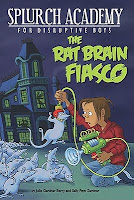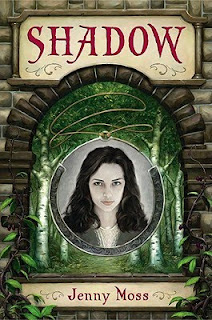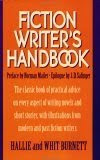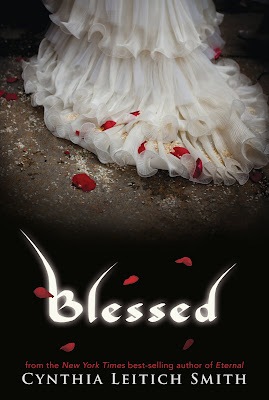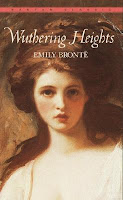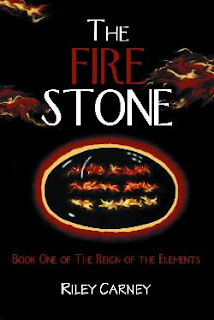 By Clare B. Dunkle
By Clare B. Dunkle
A seventh-grader once asked why I wrote about monsters. Didn’t I find it too scary?
“I can write about goblins, witches, werewolves, demons, and ghosts without losing sleep,” I told her. “But I can’t write about this.” My vague gesture took in the students, the classroom, final exams, wars, famines, and all the rest of it. “Because this is much more terrifying.”
But in spite of my best efforts to escape from real life into tales of magic, “this” has managed to sneak into my writing anyway: the plain old nastiness of one unhappy human being’s behavior towards another.
Really, without knowing it, I’ve invited that nastiness in. It goes hand in hand with writing about monsters. That’s because monsters are unusual—disturbingly different—not like us. And if history teaches us one thing, it’s that we human beings reserve our harshest, most barbaric behavior for the people who we think are not like us.
Heathcliff is a magnificent monster. His passion and brutality, his uncanny origin, his obsessive longing to reunite with his sweetheart in death—all these things make him larger than life, one of the traditional definitions of the word “monster.”
Moreover, the people he meets in Wuthering Heights (1847) immediately begin to treat him like a monster. He enters the book as a dirty, hungry little boy, a child of no more than seven. But how does his new family welcome him? By fighting over him. By threatening to throw him out into the night. By refusing him a bed. By spitting on him.
If Emily Brontë’s story were nothing more than a “poor boy does well” tale, it wouldn’t be a classic. But the fascinating fact is that Heathcliff begins at once to justify his new family’s suspicions. He doesn’t become a monster because of the family’s ill treatment. He already is a monster. He exploits his foster father’s fondness of him. He blackmails his foster brother. And, in one of the book’s most chilling moments, young Cathy watches him construct a trap over a bird nest so that the parents will have to let the baby birds starve. This breathtakingly sadistic behavior passes for play in young Heathcliff’s mind. We can only wonder what else he teaches his new playmate.
I have pondered for decades what could have happened to Heathcliff before the beginning of Emily Brontë’s classic to make him the monster he is. And when authors ponder, they write books. My new novel, The House of Dead Maids (Henry Holt, 2010), posits an entertaining explanation for Heathcliff’s behavior in Wuthering Heights. When he enters my book, he is still a little boy—a savage, dangerous, badly abused, horribly traumatized little boy. But when he leaves my book,
Viewing Blog: spookycyn, Most Recent at Top
Results 51 - 75 of 459

Cynthia Leitich Smith's "casual" blog. The blog is quirky, thoughtful, joyous, fangs-friendly musings on gothic fantasy, horror, comedy, mystery, romance, suspense, and all things life and book from an author who finds her heroes in the sunshine and in the shadows.
Statistics for spookycyn
Number of Readers that added this blog to their MyJacketFlap: 12
Blog: spookycyn (Login to Add to MyJacketFlap)
JacketFlap tags: Add a tag
Blog: spookycyn (Login to Add to MyJacketFlap)
JacketFlap tags: Add a tag
 Young Adult Novel Discovery Contest 2010 from Gotham Writers' Workshop.
Young Adult Novel Discovery Contest 2010 from Gotham Writers' Workshop.
No query? No pitch? No problem!
Submit the first 250 words of your novel, and you can win both exposure to editors and a reading of your manuscript from literary agent Regina Brooks.
Regina is the founder of Serendipity Literary Agency and the author of Writing Great Books for Young Adults. Brooks has been instrumental at establishing and building the careers of many YA writers, including three-time National Book Award Honoree and Michael Printz Honoree Marilyn Nelson, as well as Sundee T. Frazier—a Coretta Scott King Award winner, an Oprah Book Pick and an Al Roker book club selection.
The first 100 submissions will receive free autographed copies of Writing Great Books for Young Adults by Regina Brooks.
So will the top 20 submissions. The top 20 submissions also will be read by a panel of five judges comprised of top YA editors at Macmillan (Nancy Mercado, executive editor at Roaring Brook Press), Scholastic (Cheryl Klein, senior editor at Arthur Levine Books), Candlewick (Nicole Raymond, editor at Candlewick), Harlequin (Evette Porter, editor at Harlequin), Sourcebooks (Leah Hultenschmidt, executive editor at Sourcebooks) and Penguin (Leila Sales, editor at Viking). Of the 20, they will pick the top five submissions and provide each author with commentary. These five winners will also receive a free one year subscription to The Writer magazine.
These five winners will also receive a free one year subscription to The Writer magazine.
One Grand Prize Winner will win a full manuscript reading and editorial consultation from Regina Brooks and a free 10-week writing course courtesy of the Gotham Writer’s Workshop.
Please submit all entries via the contest website. One entry per person; anyone age 13+ can apply. Open to the U.S. & Canada (void where prohibited). See details.
More News & Giveaways
Track Changes Coming Back to Bite You? by Kristin from Pub Rants. Peek: "Lately we’ve received a slew of sample page submissions that have all the writer’s revisions clearly outlined in track changes." Note: see related insights from QueryTracker.
JacketFlap: "a comprehensive resource for information on the children's book industry. Thousands of published authors, illustrators, librarians, agents, editors, publicists, and publishers v
Blog: spookycyn (Login to Add to MyJacketFlap)
JacketFlap tags: Add a tag
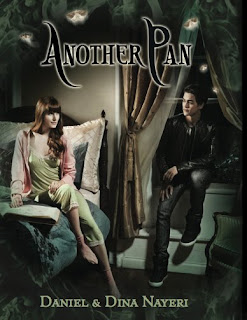 Daniel and Dina Nayeri are the debut co-authors of the Another series (Candlewick, 2009-2010). From the promotional copy of Another Pan (2010):
Daniel and Dina Nayeri are the debut co-authors of the Another series (Candlewick, 2009-2010). From the promotional copy of Another Pan (2010):
An ancient Egyptian spell is turning the tony Marlowe School into a sinister underworld. Will all hell break loose?
A darkness continues to haunt the Marlowe School, and this time, someone is plotting payback.
Wendy Darling, a headstrong junior, and her brother, John, a thirteen-year-old genius with a chip on his shoulder, struggle with being from the poorest family at the posh New York academy, where their father is a professor of ancient civilizations.
Wendy’s new boyfriend, socialite golden-boy Connor Wirth, offers a solid step up in popularity, yet ambitious Wendy and John still find themselves longing for something more.
When the Book of Gates, a mysterious tome of fabled origins, appears at Marlowe along with Peter, a dashing new resident adviser with a murky past, the Darlings are swept into a captivating world of “Lost Boys,” old-world secrets, and forbidden places.
The book opens the door to a hidden labyrinthine underworld where Egyptian myths long thought impossible become frighteningly real. Suddenly, Peter, Wendy, and John find themselves captive in the lair of an age-old darkness, trying to escape the clutches of an ancient and beautiful child-thief who refuses to let go.
Could you describe both your pre-and-post contract revision process? What did you learn along the way? How did you feel at each stage? What advice do you have for other writers on the subject of revision? Dina: I’ve only been writing professionally for a few years, but during that time I’ve worked on novels both alone and with my brother. In both contexts, I had to learn how very important it is not to be attached to any of your writing. The number of times we have edited our own work, or each other’s--both before and after the contract--has been staggering.
Dina: I’ve only been writing professionally for a few years, but during that time I’ve worked on novels both alone and with my brother. In both contexts, I had to learn how very important it is not to be attached to any of your writing. The number of times we have edited our own work, or each other’s--both before and after the contract--has been staggering.
At first, of course, I was daunted by the sheer volume of edits from so many different sources (my co-author, readers, editors, my agent). But now it’s reassuring to know how many chances you get to make your novel better.
With each novel, the revision process has been different. With Another Faust (Candlewick, 2009), we sold the novel after a certain number of private revisions (just between Daniel and I) and then our editor gave us a list of very high-level changes, followed by two-three rounds of smaller changes.
But the editing process for Another Pan was completely different. Because we had sold the novel to Candlewick before a word of it was written, our editor didn’t really know that she would like it at all before we submitted something to her. With Another Faust, at least she had read it before deciding to become involved.
Blog: spookycyn (Login to Add to MyJacketFlap)
JacketFlap tags: Add a tag
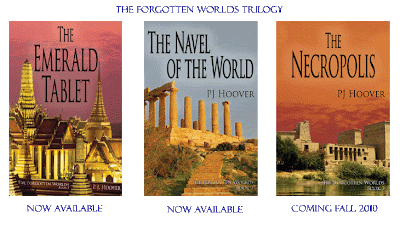 Congratulations to P.J. Hoover on the release of The Forgotten Worlds Book 3: The Necropolis (CBAY/Blooming Tree, 2010)! From the promotional copy: "The situation in Lemuria is rapidly deteriorating. In fact teleportation between the hidden continent and the outside world has become so dangerous, all agents and their families have been recalled. Although Benjamin is pleased to be living in Lemuria full time, he knows he needs to find his last sibling soon. However, between classes, a murderous half-brother, and complications with his friend Heidi, Benjamin can barely focus. Besides, there's only one place left they haven't searched - the hidden continent of Atlantis." See a guest blog by P.J. and Jessica Lee Anderson on Sophomore Novels.
Congratulations to P.J. Hoover on the release of The Forgotten Worlds Book 3: The Necropolis (CBAY/Blooming Tree, 2010)! From the promotional copy: "The situation in Lemuria is rapidly deteriorating. In fact teleportation between the hidden continent and the outside world has become so dangerous, all agents and their families have been recalled. Although Benjamin is pleased to be living in Lemuria full time, he knows he needs to find his last sibling soon. However, between classes, a murderous half-brother, and complications with his friend Heidi, Benjamin can barely focus. Besides, there's only one place left they haven't searched - the hidden continent of Atlantis." See a guest blog by P.J. and Jessica Lee Anderson on Sophomore Novels.
What's an Imprint? by Stacy Whitman from Stacy Whitman's Grimoire. Peek: "First off, let's distinguish between a smaller company and an imprint. Big and small publishers will both have imprints. You may have an advantage getting published with a smaller press because they'll often be able to give more personalized attention from the editorial stage on through production and promotion---though that can depend, too." Read a Cynsations interview with Stacy.
Children's Writer-in-Residence: Thurber House invites authors to apply for the 2011 residency in children's literature. Peek: "The Thurber House Residency in Children’s Literature offers talented, emerging writers a month-long retreat in a lovely, quiet living and working environment in James Thurber’s home in Columbus, Ohio. Besides having time to focus on his/her own writing project, the resident will teach writing-based activities to middle-grade children in a variety of community settings, including the Thurber Summer Writing Camp."
Walking the Edge by Sarah Bromley from The Slanted Mirror. Peek: "In my opinion, edgy is more ground-breaking than gritty. Gritty is more often a dark tone and a pervasive seediness, a moral ambiguity, that flows throughout the story. But edgy is the subject matter at the heart of the book."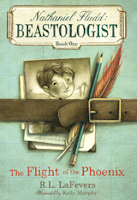 The Shrinking Violet Online Personal Workshop Week One, Week Two: The Many Layers of You, Week Three: Connecting the Dots from
The Shrinking Violet Online Personal Workshop Week One, Week Two: The Many Layers of You, Week Three: Connecting the Dots from
Blog: spookycyn (Login to Add to MyJacketFlap)
JacketFlap tags: Add a tag
 By Brian Yansky
By Brian Yansky
I’ve written elsewhere that my first short-story, “Santa Claus and the Twenty-seven Bad Boys,” which was written in the first grade, neatly outlined my material for a lifetime of fiction writing: it had a stubborn fascination in the mythological and supernatural creatures that haunt and enliven our culture, an affection for odd and strange characters, and a desire to be both comic and serious.
While this is surely true, I don’t think I found the complete expression of it until I wrote Alien Invasions and Other Inconveniences (Candlewick, 2010)(chapter one PDF).
What I mean is this: though writing quirky novels was nothing new to me, the fantastical elements in those novels was never central to them. The novels were rooted in realism and the fantastical events were appendages added to them in various ways for various purposes. I’d published two of these novels. Both of them had received mostly good reviews and one had won a prestigious award, but neither had sold particularly well.
After those, I’d written my next novel, and that novel had been rejected by my editor and several other editors. After those rejections I have to admit, rightly or wrongly, to a feeling that I was doing something wrong. And I have to admit I had no reason to believe there would be a line of publishers interested in my next manuscript if it were like the others. So what I thought at that point was I needed to try writing a more conventional novel. I needed to reel in my quirky characters and mute the fantasy element. I needed to try something different.
With this in mind, I started a novel. It died after twenty or thirty pages. I started another and same thing happened. This went on for a while. I did what writers in a bad place must do, I kept writing. Eventually I started one that began, “It takes less time for them to conquer the world than it takes me to brush my teeth.” Okay, I thought. Kind of funny. Kind of weird.
But not more conventional.
Not following the plan.
I was about to erase the line when another came. “That’s pretty disappointing.”
I had a voice. I couldn’t deny I had a voice. Every writer loves when they feel they have a voice, a narrator who speaks distinctly. But this was still not the novel I had planned. This was definitely not that novel. My finger hovered over the DELETE key.
But, come on, I had a voice. I remember thinking to myself, “Really? You’re really going to write this novel? This totally unsellable even-weirder-than-usual novel? Really?”
I remember thinking to myself, “Really? You’re really going to write this novel? This totally unsellable even-weirder-than-usual novel? Really?”
Be reasonable, I thought. A novel takes a year. Maybe more. No on gets that many of those.
But I had a voice. I had a character. What could I do?
(Let me interject here that there are many wonderful conventional novels, but that, for me, writing a con
Blog: spookycyn (Login to Add to MyJacketFlap)
JacketFlap tags: Add a tag
I'm not involved as a blogger or author, but I look forward to reading the Crossroads Blog Tour.
In It for the Long Haul by Rachelle Gardner from Rants & Ramblings on Life as a Literary Agent. Peek: "...what helps a writer accomplish this goal – and what can sabotage their efforts."
When You Discover Your Agent's Not That Into You by Brodi Ashton from Nathan Bransford - Literary Agent. Peek: "I’m still friends with my first agent, and I admit I learned so much from him. But I would rather be in the query pool, collecting a thousand rejections, than be with an agent whose reaction to my book was, 'Meh.'" See also The All-Important First Chapter by Valerie Kemp from Nathan.
Writing Fight Scenes by Leah Cypress, featuring insights from Jenny Moss, Ellen Oh, Malinda Lo, Dawn Metcalf, Lia Keyes, and Caroline Hooton, from The Enchanted Inkpot. Peek from Ellen: "We have to know that in a fight, the brain doesn't completely go blank. Capturing the heightened intensity of the character's emotions is what makes a fight scene really come alive."
Cobwebs Got Your Story? by Carolyn Kaufman from QueryTracker. Peek: "Unsettled, I peer around the corners into the nooks and crannies of the story only to find sheets of lacy cobwebs and the mummified remains of plot bunnies that didn't quiet make it out to the green pasture before I tucked the story away. Dust coats nearly everything, giving my story a surreal, fuzzy feeling."
Master List of YA Literary Magazines and Journals by S.E. Sinkhorn from maybe genius. Peek: "These are mostly magazines that are on a paying scale, which means they're pro or semi-pro. Some of them don't pay, but are still of a high quality. I'm going to list the magazine/journal along with a link, the age group it's aimed at, and a short description." Source: Alice Pope's SCBWI Market Guide.
New Agent Interview: John Rudolph, Dystel & Goderich Literary Management by Alice Pope from Alice Pope's SCBWI Market Guide. Peek: "Right now, I’m open to pretty much anything and everything, though I will say that I’m not actively looking for picture book manuscripts unless they’re by author/illustrators."
Spooky Screening Room
Nightshade by Andrea Cremer (Philomel, Oct. 19, 2010) ARC giveaway from P.J. Hoover at Roots in Myth. Deadline: midnight Oct. 22. Check out the book trailer below.
Blog: spookycyn (Login to Add to MyJacketFlap)
JacketFlap tags: Add a tag
 Sara Beitia is the first-time author of The Last Good Place of Lily Odilon (Flux, 2010)(author blog). From the promotional copy:
Sara Beitia is the first-time author of The Last Good Place of Lily Odilon (Flux, 2010)(author blog). From the promotional copy:
We've been over this, he says. We have to get to her first.
I know! Olivia snaps. I'm keeping company with a suspected murderer and I've probably become an accessory at this point, and a runaway besides. So don't tell me what I need to do. I'm doing it.
Lily Odilon--local wild child from a small Idaho town--has vanished after spending the night with her sometimes boyfriend, new kid Albert Morales. Suspected in her disappearance, Albert sets out to discover what happened to her. Kidnapped? Runaway? Murder victim?
Joining Albert is Lily's prickly younger sister, Olivia. Their distress is mirrored in a fast-paced narrative that jumps through three timelines. Each thread adds a new level to the mystery and reveals clues that paint a startling picture of all three teens. Their intertwined destinies come to a head in an unconventional climax.
Are you a plotter or a plunger? Do you outline first, write to explore first, or engage some combination of the two? Then where do you go from there? What about this approach appeals to you? What advice do you have for beginning writers struggling with plot?
I am a plotter, and firmly so. I look at this way: A coherent book needs a plot and a structure to serve the plot, and figuring all that out beforehand is like having a rough road map. Rough, because there will always be surprises as you progress, no matter how much you’ve worked out in advance—blind alleys and unexpected turns that keep the process exciting.
I love stories, and I love the mechanics of crafting them. What keeps me from throwing my computer through the window when things aren’t working is taking a step back, going back to that plot touchstone, and then returning with a renewed confidence that I can get the story out and get it right.
We all know that the plot is what happens in the book, but it’s more difficult to spot what makes a good one.
To a beginning writer struggling with this, I would say: Identify the story you want to tell—what does your protagonist want, what stands between her and her goal, and how does she get it? In other words, what is the conflict? And even more, is it a conflict your readers are going to care about? Will it be a satisfying journey? This is a good place to start the work, anyway.
I do a lot of the plot exploration as I work my way through an initial outline, and it can take me weeks and several revisions to work out and get down on paper what I want to do before I begin chapter one. Once I’m down to the actual writing, I will find all sorts of ways in which I need to tweak my outline, but it keeps me sane to have a narrative reference point.
The plot of The Last Good Place of Lily Odilon turns heavily on its structure. There are three separate time threads (color coded in the original outline to keep them straight)—a timeline of events leading up to a "present tense" timeline (told in regular past tense); italicized past-tense flashbacks, and a "present tense" timeline marked with t
Blog: spookycyn (Login to Add to MyJacketFlap)
JacketFlap tags: Add a tag
 Tracy Trivas is the first-time children's author of The Wish Stealers (Simon & Schuster, 2010). From the promotional copy:
Tracy Trivas is the first-time children's author of The Wish Stealers (Simon & Schuster, 2010). From the promotional copy:
Griffin Penshine is always making wishes. But when a sinister old woman tricks her into accepting a box of eleven shiny Indian Head pennies from 1897, Griffin soon learns these are no ordinary pennies, but stolen wishes.
This box of labeled pennies comes with a horrible curse: People in possession of the stolen coins are Wish Stealers, who will never have their wishes granted.... In fact, the opposite of what they've wished for will happen.
Griffin must find a way to return these stolen wishes and undo the curse if her own wishes are to come true. But how can Griffin return wishes to strangers who might not even be alive?
Her journey leads her to ancient alchemists, Macbeth's witches, and a chance to help people in ways she never imagined, but the temptation of the Wish Stealers' dark and compelling power is growing stronger.
Can Griffin reverse the curse in time to save herself and the people she loves?
Tracy Trivas's rich and imaginative début novel introduces a talent as bright and sparkling as Griffin's pennies.
What were you like as a young reader, and how did that influence the book that you're debuting this year?
Years before I had The Wish Stealers published, I directed a gifted and talented program and taught English. My classroom door had some of my favorite quotes taped to it on colored paper—alerting students they were entering a world of words…a place where, when we read Edgar Allan Poe for example, I put all their desks together, draped our new center “banquet table” in purple velvet, set plastic “wine goblets” filled with dark red cranberry juice on top, shut off the lights, and lit an eyeball-shaped candle. Then we’d go around the table and read aloud, lingering on beautiful sentences and strange concoctions of words. The kids loved it, and even the most reluctant students started to open up to the power of words and the beauty of language.
In my classroom, I had a wall dedicated to Noah Webster, and I displayed a giant honored dictionary underneath it.
Every Wednesday, we had “Wacky Word Wednesday” and the children had to bring in quirky words and set them to pictures.
This love of words and beautiful sentences began early for me. As a child, I was a voracious reader, and without knowing why, I’d hand copy favorite sentences from books into a diary, as if trying to capture them, or maybe subconsciously absorb their structure.
On Tuesday nights, when I was very young, my dad would drive me in our big old faux-wood-paneled station wagon to the town library where we’d max out our library cards. After an hour of book hunting, my dad would retrieve the car and double-park at the curb as I tottered out the library doors with a giant tower of books, giddy with my new finds.
My dad introduced me to the library early. I remember the pride I felt getting my first library card, signing it with my wobbly six-year-old signature….
Blog: spookycyn (Login to Add to MyJacketFlap)
JacketFlap tags: Add a tag
 Interview with Middle Grade Novelist Royce Buckingham by Clete Barrett Smith from Through the Tollbooth. Note: "Royce Buckingham is a Pacific Northwest author who specializes in boy-friendly fiction. His latest book, the supernatural mystery/thriller The Dead Boys, was released by Putnam on September 2 and is a Junior Library Guild Selection." Peek: "It’s a knife-edge, so to speak, because you’re trying to scare them but you’re not trying to traumatize them." See also Clete on Things I've Learned about Writing Novels from Reading Comics.
Interview with Middle Grade Novelist Royce Buckingham by Clete Barrett Smith from Through the Tollbooth. Note: "Royce Buckingham is a Pacific Northwest author who specializes in boy-friendly fiction. His latest book, the supernatural mystery/thriller The Dead Boys, was released by Putnam on September 2 and is a Junior Library Guild Selection." Peek: "It’s a knife-edge, so to speak, because you’re trying to scare them but you’re not trying to traumatize them." See also Clete on Things I've Learned about Writing Novels from Reading Comics.
Twitter Book Parties! a celebration of new books for kids, tweens, and teens. Peek: "The day your book releases (full list here), we'll spread the news, raise a glass, break out the chocolate, and virtually party with you. I’ll also provide a link to an independent bookseller of your choice (send me the link featuring your book) or to IndieBound so that thousands of tweeps can buy your book."
Nominate the Best Books of the Year for the Children's and Young Adult Bloggers' Literary Awards (the Cybils). Books published between Oct. 16, 2009, and Oct. 15, 2010, are eligible. Note: my upcoming picture book, Holler Loudly (Dutton, 2010), is not eligible; it's official publication date is Nov. 11.
Congratulations to Georgia McBride, founder of YALITCHAT, on signing with Mark McVeigh of The McVeigh Agency, and congratulations to Mark on signing Georgia! Read a Cynsations interview with Mark.
Defeating Your Inner Critic Part I: Track the Problem by Carolyn Kaufman from Query Tracker. Peek: "The Inner Critic can be the writer’s worst enemy. Each time we sit down to work, it feeds on our insecurities, reminds us of past failures, and criticizes everything we put down on paper." See also Part II: Put the Critic on the Stand. When Back List Books Go POD from April Henry. Peek: "One downside to this idea is that a book might never be considered out-of-print, so the rights would never revert back to the author. Speaking as someone who made a few dollars putting her out-of-print backlist on the Kindle..
When Back List Books Go POD from April Henry. Peek: "One downside to this idea is that a book might never be considered out-of-print, so the rights would never revert back to the author. Speaking as someone who made a few dollars putting her out-of-print backlist on the Kindle..
Blog: spookycyn (Login to Add to MyJacketFlap)
JacketFlap tags: Add a tag
 Matthew J. Kirby is the first-time author of The Clockwork Three (Scholastic, 2010). From the promotional copy:
Matthew J. Kirby is the first-time author of The Clockwork Three (Scholastic, 2010). From the promotional copy:
Three ordinary children are brought together by extraordinary events. . .
Giuseppe is an orphaned street musician from Italy, who was sold by his uncle to work as a slave for an evil padrone in the U.S. But when a mysterious green violin enters his life he begins to imagine a life of freedom.
Hannah is a soft-hearted, strong-willed girl from the tenements, who supports her family as a hotel maid when tragedy strikes and her father can no longer work. She learns about a hidden treasure, which she knows will save her family -- if she can find it.
And Frederick, the talented and intense clockmaker's apprentice, seeks to learn the truth about his mother while trying to forget the nightmares of the orphanage where she left him. He is determined to build an automaton and enter the clockmakers' guild -- if only he can create a working head.
Together, the three discover they have phenomenal power when they team up as friends, and that they can overcome even the darkest of fears.
Are you a plotter or a plunger? Do you outline first, write to explore first, or engage some combination of the two? Then where do you go from there? What about this approach appeals to you?
Of the two, I guess I would be considered a plunger, but a slightly apprehensive one. It’s like traveling to a place I’ve never been, where I don’t know the language or the culture. I really like to travel, and I’m always excited to go someplace new and different, but I’m also a bit nervous.
Maybe I wouldn’t be as nervous if I had a better idea of my destination, but I don’t outline in the formal sense. At most, I might jot down some ideas, some images, or snippets of dialogue that I plan to use. I do usually have some mile markers in mind, which some might think of as a kind of outline, and I guess it is. But it isn’t a map.
To continue the traveling metaphor, if a writer who does follow a strict outline has a GPS, and a map, and a satellite phone, what I have are vague directions I picked up from a stranger I met on the side of the road. And that’s the way I like it.
Of course, now that I’ve said all that, I have to admit I did outline some of The Clockwork Three though much less than people think. The book has three protagonists, each with their own separate but interlocking stories. The majority of the book I wrote without an outline, but when I hit the last three chapters I had to lay it all out and organize it. I created a spreadsheet with columns for the different plotlines so I could see where they overlapped and lined up, departing from my usual on-the-fly way of doing things to make sure I wrapped up all the loose ends how I wanted to (which also meant leaving some threads intentionally hanging in the wind). But I haven’t felt the need to do that for any of my other stories.





